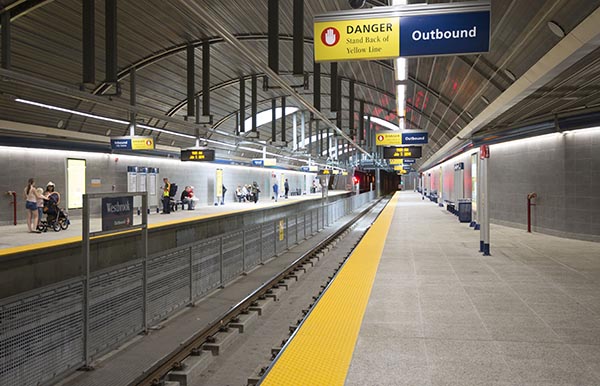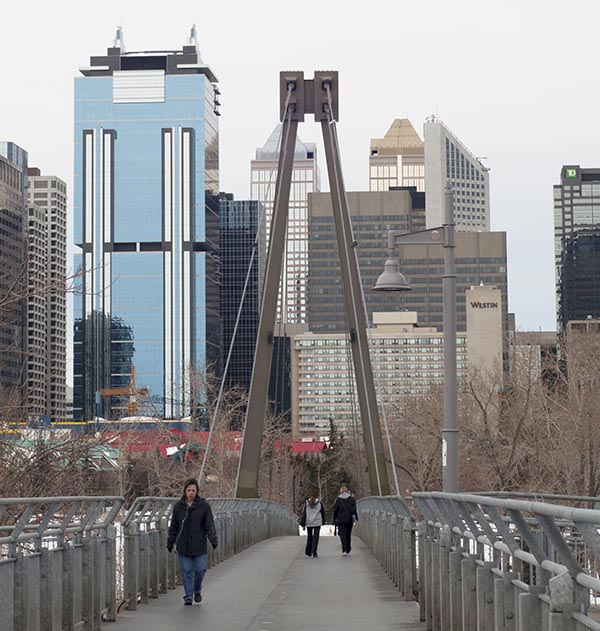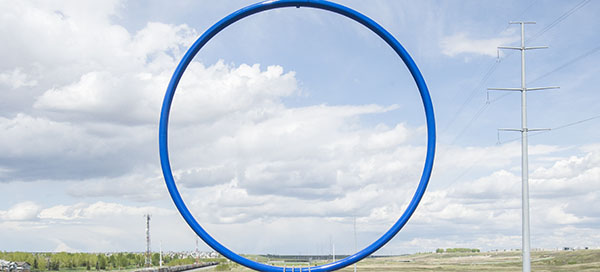
March 30, 2015 | Jamie Zachary
Beyond public art
Program's controversy has raised the profile of placemaking. Yet how has Calgary fared in designing its public space?Sitting in his home studio located just south of the city, Derek Besant chuckles when asked to score Calgary's efforts at developing its public spaces.
It's like asking an artist to judge his own work.
The local artist's work is familiar with many Calgarians, having designed the iconic six-metre tall balancing-chair display dubbed Homage that has sat outside Mount Royal University's student union building since the late 1980s, as well as the Enigma exhibit that once stood at the school's east entrance. Besant, an instructor at Alberta College of Art & Design since the late '70s, was also behind the Skywalk display on the Canyon Meadows pedestrian walkway over Macleod Trail S., the Songlines illuminated fibre-optic outdoor drawings surrounding Olympic Plaza and the 72-glass-square Wander exhibit integrated into the LRT station at Seventh Avenue and First Street S.W. – to name a few.
More recently, he created the controversial I am the River piece (2010-13) in the East Village, where he placed large photos of people floating on the abutments of the Langevin Bridge and public washrooms in front of the Simmons Building on RiverWalk.
"It's a re-evaluation of the everyday cityscape," he said of Calgary's re-imagined public spaces, dubbed by urban planners as placemaking. "(It's) a moment when you're just riding the train, walking to work, cycling or driving in the car that redefines the city for you. They don't have to be monumentally big things. They can be small things. A handrail designed properly can affect your transition through space."
While placemaking has long been part of many urban planners' vocabulary, it's only recently become part of Calgarians' lexicon as the city struggles to balance growth with thoughtful design — manifested, in large part, through the much-discussed public art program.
Commonly referred to as the planning, design and management of public spaces, placemaking is more so the ability to take an area and raise its public consciousness, said Besant.
"The biggest definition of placemaking is knowing you're there," said Besant, whose public commissions outside of Calgary include the Flatiron Mural behind Toronto's landmark Gooderham flatiron building on Front Street, as well as the murals for Worldwide Centre at 58th and Eighth in New York City. "Art can do that. Art can have those moments of recognition for somebody."
Yet art in itself does not define placemaking, said Thom Mahler, manager of centre west planning area for the City of Calgary.
The City's placemaking efforts are guided by the Municipal Development Plan (MDP), which includes direction on everything from the development of parks and open spaces to transportation corridors and public art.
Mahler noted the plan recently led planners through the West LRT line's development in the city's southwest.
"While we were doing the planning and designing of that, there was a big emphasis around each of the stations to create some sense of place instead of just a place for people to get on and off," he said. "At the Westbrook Station, in particular, we created a plan to make sure there would be opportunities for social interaction and 'public rooms.' We focused on a plaza near the transit station. There's also a park that's part of that, although we haven't done any detailed park design yet."

Mahler further references the Main Streets program where the City is working to revitalize 24 transportation corridors, as identified in the MDP, in communities such as Bowness, Kensington and Bridgeland.
"We're getting very pragmatic suggestions for people, such as adding lights and widening sidewalks," he said. "It's where we're trying to find stuff that's low-cost or no-cost instead of waiting for something like a big massive park redevelopment to make that happen.
"The best-loved places are not designed at all. A very simple example is Stephen Avenue Mall. It's essentially just a street – a lot of the buildings were put up long before anyone thought about making it a place. But the fact we turned it into a pedestrian mall leveraged off the fact that it was already a special place in Calgary."
Overall, Mahler believes Calgary is faring well on the national placemaking stage.
"As a place where we have a lot of growth and change, we have examples that we can point to where we are doing international-quality placemaking, such as East Village and the river pathway system," he said. "We are starting to build examples that other cities will reference."
The problem, however, might be in continuing that momentum.
Placemaking faces the struggle of staying relevant, argues Richard White, a Calgary-based columnist who has been writing on urban development, including public art, for more than three decades.
While being able to capture people's interest and imagination for the first five years, placemakers tend to fade from the public eye over time as they begin show their age and as new projects come online, he said.
"Eau Claire market could be considered placemaking," said White. "In the early 1990s, they put in the waterpark, old chimney, old windmill, the market, fish ponds that were supposed to support a busker area and everyone was excited for the first three to five years. Then it wore thin, and 20 years later it's in need of repairs. It should have lasted more than 20 years.

"We're doing lots of (placemaking) ..., but a lot of them are not capturing the public's imagination."
White has sat on numerous public art selection committees, both within Calgary and Western Canada, including the City's public art board and Calgary Allied Arts Foundation's board.
He was also part of a Calgary Downtown Association task force that helped give life to a number of popular features in the core, include the stone sculptures in front of Barclay Mall on Third Street S.W.
White points to the Plus-15 system downtown as an example of, and a continued opportunity to, create placemakers.
He was involved in advising on the esthetic redevelopment of the above-ground structures throughout the core in the 1990s – in particular, "getting people to start to think of them as art objects and not just as utilitarian boxes."
"The thought starts out very good," he said of Plus-15s system, which was conceived and designed by Harold Hanen in 1970 and today comprises 59 enclosed bridges stretching throughout downtown.
"It's an adaptation to winter; it moves people off the streets, which means there's less interaction between cars and people; and it's much better than an underground system in that you get to enjoy the beautiful winter sun that we have in Calgary as opposed to Montreal and Toronto where you have underground systems and never see the sun."
As part of his role, White helped reshape the current Plus-15 above Sixth Avenue at Sixth Street S.W. designed by architect David La Chapelle that includes a vista of the triangular shapes resembling mountains as people leave downtown.
With the Plus-15 infrastructure more than four decades old, White argues now is the perfect time to start thinking outside of the box again.
"We should be taking a system that's now 40 years old and looking at it creatively to make it much more of a public space," he said. "Right now, it's mainly a walkway or sidewalk, but it could become a tourist attraction."
The concept of placemaking being creative by virtue of the spots they are situated is, in part, motivating the current Lost Spaces competition being organized by the Design Talks Institute (d.Talks), a Calgary-based non-profit organization dedicated to sparking conversations about design and the built environment in Calgary.
The competition (www.dtalks.org/call-for-ideas), which was launched in early January, is seeking submissions up to the end of March on how to better use the city's unused spaces – ranging from a passageway or roundabout to space between two buildings or a highway shoulder.
"The idea behind the competition was to think about the purposes of these lost spaces, and the opportunities at what we could possible change," said d.Talks co-founder Amery Calvelli.
"Some of the surprises that have come out of this exploration are that ... there are opportunities to address what they function as now while also creating a space that might be more connected to the public realm or different types of activities."
Calvelli said the Lost Spaces competition wasn't so much a commentary on Calgary's current state, but more so an opportunity to highlight the inevitable consequences urban centres face as they evolve.
"Every place struggles with these lost spaces," she said. "These are really difficult spaces. They're cutaways. They're remnants. They're places that get left behind. We're not unique in that.
"It's not that we're saying Calgary has this huge problem. We're asking what are these spaces and how can we use them? The biggest takeaways we hope are overall awareness about lost spaces and the ability for people to help design this city."
The concept of designing the city has also captured the public's attention through Calgary's controversial public art efforts — yet sometimes for the wrong reasons.
Last summer, the Travelling Light exhibit in the city's northeast - on the 96th Avenue bridge near Deerfoot Trail, set off a firestorm among Calgarians, with many, including Mayor Naheed Nenshi, questioning both the artistic value and price tag of the $470,000 blue ring, created by Swedish group Inges Idee.

Last fall, a Calgary woman came forward after the Wishing Well exhibit in front of Genesis Centre in the city's northeast reflected sunlight so intense it burned a hole through her coat. The $559,000 sculpture created by California artist Living Lenses is a giant mirrored steel ball split in half and hollow that includes a sound and light display.
More recently, a motion set by Coun. Peter Demong to freeze the city's public art budget for 2015 in light of weak oil prices was defeated in council by a 9-5 vote. Yet, it wasn't before an outcry from public art supporters, prompting Demong to say he's been "vilified" over the motion.
Among the chorus of critics was Deborah Herringer Kiss, owner of the Herringer Kiss Gallery and board member of the Art Dealers Association of Canada. Herringer Kiss argued the motion not only threatened the local arts and cultural community, but Calgary's hard-earned reputation as an art-friendly city.
"(Public art) puts the city on an international map, and makes Calgary known as a city that has a public arts program and pieces around the city to see," she said.
"It says a lot about the city and what kind of city we want to be. We struggle here with a sort of cowboy, oil-town image that sometimes overshadows the fact we have a really strong art community."
Herringer Kiss, who has sat on several committees with a budget to spend on public art for buildings, also believes that similar developer incentive initiatives, such as the bonus density program, benefit all Calgarians in that it brings culture to the city's streets in a literal way.
"That trickles down to everyone in the community, whether it's artists, art movers, art installers or art galleries," she said.
The popular Wonderland sculpture – a 12-metre-tall bent-wire portrait of a young girl's head by Spanish sculptor Jaume Plensa – at the base of The Bow, is a byproduct of the City's bonus density program in which developers are granted additional bonus floor area in exchange for providing certain amenities, such as public art.
Additional examples of the bonus density program include Jamieson Place's winter garden, a 25,000-square-foot area facing Third Avenue S.W. including a three-storey high living wall; as well as The Orchard on Twelfth's apple orchard and urban park, which is expected to open in spring 2018.
In addition, the City operates community investment funds in the Beltline, Eau Claire, Chinatown, west downtown and downtown allowing developers to build greater density by adding extra floors in exchange for their support of public space improvement projects. Examples include streetscape improvements, park and open space redevelopment, street trees and furniture and public art.

Despite council's vote, White thinks the debate over the city's public art program, in addition to the various density programs, will continue to exist.
"I don't think it will ever go away. I think there will always be people who don't like public art," he said, noting the City's 2014 Satisfaction Survey in which 25 per cent of Calgarians indicated the City should invest more in arts and culture, 56 per cent wanted to keep spending the same and 16 per cent said they wanted the City to spend less.
"The City has a process that's as good or better of anything I've ever seen. It's thorough. It's detailed. They added more areas for public feedback ... I don't know why the City seems to be unlucky in not being able to get pieces that capture the public's imagination. They need some winners. They've had some losers."
Added Besant: "They've hit some and they've missed some. The biggest thing that I would focus on would be the fact that we have a public art program."
Besant argues while these initiatives provide a net benefit to placemaking, in the city, it still needs to be done in relation to the surroundings – something Calgary seems to be struggling with so far.
"It's not just plunking sculpture down. It's got to have a context," he said. "And that's one of the biggest challenges with Calgary's public art program. It's a matter of being able to work with the city, know what's going on and get some of these integrations in the right place that can do the right job.
"It has to part of the fabric of an area, and it has to evolve. If that's successful, people will take ownership of it."
White further posits that the controversy around public art in the city has led to the inevitable question as to whether local government is the best place for public interest design?
"That's always going to be the billion-dollar question," said Besant. "There are certain people, for example, who argue the private sector does a better job."
Herringer Kiss believes elected officials need to not just be stakeholders in the arts community, but champions. She argues it takes local government to make others see the overall benefit of initiatives such as the public art program.
"Unfortunately, at times, we've seen the general public speak out about public art in the city and spending money on (it), and it takes our leaders to see the trees through the forest and realize this is an investment that's good for the community, it's good for our people and it draws people to the city," she said.
Mahler argues while local government has a role to play in placemaking, including public art, it cannot be the sole stakeholder if it's to succeed.
"We're just a role player. The best place for public design is in public discussion," he said, noting community associations, developers and trade groups all have a role in the process. "Any particular interest group can be the lead or catalyst for that kind of conversation."
He points to community associations as a key player in driving placemaking efforts beyond the core – primarily through their respective community halls, which can act as focal points. He singles out the Sunalta Community Association, which is anticipating future population growth by looking for ways it can redevelop its aging hall in a way that better engages residents.
Placemaking as a collaborative responsibility is a sentiment echoed by industry groups such as the National Association of REALTORS®, which encourages its U.S. members' participation through micro-grant and "smart growth" grant programs.
Here in Calgary, CREB® president Corinne Lyall agrees placemaking is an opportunity for everyone to get involved, as well as a way to increase social interaction in a creative setting that ultimately benefits residents and visitors alike.
"It's an exciting concept because it can have such a transformative effect on public spaces," she said.
"Whether it's a mural painting project that brings neighbours together, a little free library on a street corner or a community garden that brings beauty to an underutilized piece of land, finding new and creative ways to engage with public space can add vibrancy to a community.
"REALTORS® are both personally and professionally invested in the communities in which they live and work. As a REALTOR®, I can see a real value to projects that seek to strengthen community connections and enhance quality of life. Real estate connects people to possibility; placemaking looks for creative ways to connect people to the space in which they live."
Looking forward, White suggests placemaking should not be limited to the core or inner city. In Calgary, he points to current efforts that are doing just that, such as the Rotary/Mattamy Greenway. Led by Parks Foundation Calgary, the greenway, when complete, will be a 138-kilometre network of parks and pathways that will encircle the city.
As a placemaker, Calgary is on par with any other city in Canada over the past 10 to 15 years, said White. He agrees the city has also stirred up controversy through its efforts, but argues that's not a bad thing.
"Through Wonderland and through Travelling Light, Calgary's been pushing the boundaries," he said. "At least we're trying things. Like all research and development, not everything works. And to me, city building is one continuous experiment. There is no recipe for placemaking."
Tagged: Calgary | Calgary Community | Design | placemaking | Travelling Light




